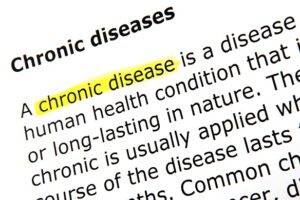Table of Contents
Introduction
Learn about the risk factors for chronic diseases, such as heart disease, stroke, type 2 diabetes, and cancer. Find out what you can do to reduce your risk and improve your health. The following risk factors are discussed:
Behavioral risk factors: Smoking, Alcohol consumption, Physical inactivity & Poor diet
Physiological risk factors: Obesity, hypertension, high cholesterol & diabetes
Other risk factors: Genetics, Environment, Inflammation & Insulin resistance
——————————————————————————————————————
Not the underlying cause of chronic diseases
Risk factors are not the root cause of chronic diseases. The root cause should be only one. It may be named differently. The objective of the blog is to present information on the risk factors so readers know about them.
There are many conditions described as risk factors described of chronic diseases. These risk factors are not the underlying cause or the root cause or chronic diseases. The information on risk factors is necessary so that we can compare it with the root cause. The root cause has be one, knowing which the solution to chronic diseases becomes easy.
What should one do once he learns that chronic diseases are not curable and it is going to persist for a long period of time? Wait for the answer to come from the doctor, WHO, or health policymakers, or find it for yourself!
The answer will not come from the doctor. He is a very learned person and is very good at diagnosing diseases through physical check-ups, pathological tests, blood tests, and various modern diagnostic tools available nowadays like X – rays, sonography, blood pressure monitoring, biopsy test, and CT scanners. With the help of all these tools, whether necessary or not, he is able to tell you which disease you are suffering from like diabetes, blood pressure, coronary artery disease, cancer, and so on.
But when it comes to treatment he can use medications and also use surgical methods if required. For each disease, there are several synthetic drugs having some pharmacological activity. These drugs suppress the symptoms. For example, if you have a fever, a drug is given which will lower the body temperature. But when its action is over fever may come again. The doctor has cured the fever or not? Why the fever has come? The fever must have come for some other reason. If our body has been attacked by some infection, our immune system tries to fight the organism and try to remove it from the body. When the fight is over the temperature comes down.
Doctors job is to diagnose you and say, your blood sugar levels are high or cholesterol levels are high or there is a tumor in the throat. The doctor will prescribe you a drug to lower your blood glucose levels because your blood sugar levels are high. He is not looking into how and why blood sugar levels increased. Similarly, he prescribes you a statin drug to lower blood cholesterol levels. For the tumor growth, he will perform a surgical operation and remove the tumor. All of these are symptomatic treatment procedures and not the treatment for the underlying cause.
————————————————————————————————————————-
Treat the symptoms, not the cause
The underlying philosophy in allopathy is to treat the symptoms and not the underlying cause. These diseases are usually difficult to cure or may even be incurable. Treatment may mostly involve managing the symptoms of the disease through medications, lifestyle changes, diet, and exercise.
Treatment for the chronic illness depends on the underlying disorder. A doctor will diagnose the condition and will begin treatment accordingly. The course of treatment for chronic illnesses will differ from one to the other. For instance, the treatment for asthma will be different from the treatment for cardiovascular diseases.
For any heart related conditions, the doctors will likely prescribe medicine that facilitates the flow of blood from the heart to other parts of the body. Similarly, in case of asthma, doctors may only ask the patient to use an inhaler.
In the case of diabetic patients, regular insulin shots are usually used. The insulin helps regulate the blood sugar levels in the blood. Colorectal and lung cancer on the other hand are treated with the help of radiation therapy and chemotherapy.
Depression is often caused as a side effect of chronic illness. This must also be treated with proper medication and psychiatric counseling.
—————————————————————————————————————————-
Risk factors in place of root causes

Allopathic medicine prefers to use risk factors as being responsible for the cause of chronic diseases. These risk factors are based on the behavior of a person, physiological factors, genetics, and environmental factors.
Here are the examples of the risk factors:
- Behavioral risk factors;
- Physiological risk factors;
- Genetics and
- Environmental factors.
Four behavioral risk factors have been identified that may be the cause of the disease:
- Smoking: Smoking leads to a number of chronic diseases including COPD.
- Consuming alcohol: Alcohol mainly causes metabolic disorders and cirrhosis of the liver.
- Physical inactivity: Sedentary lifestyle causes obesity.
- Poor diet: Poor diet is the main risk factor as our life depends upon the food we eat.
Physiological risk factors are the following:
- Obesity: If you do not exercise, you tend to put on weight and obesity is a high risk for diabetes.
- Hypertension: If you are hypertensive and have high blood pressure, you are at risk of heart attack, stroke, or heart disease.
- High cholesterol levels: If your serum cholesterol levels are high you are at a high risk of heart disease.
- Diabetes: If you are diabetic you are at the risk of heart disease. Most of people suffering from diabetes also suffer from heart disease, chronic kidney disease, eye disease, and so on.
Genetics and environment as risk factors
- Genetics: Most chronic diseases are due to fault genes.
- Environmental factors: Pollution due to water and air are also contributors to chronic diseases.
———————————————————————————————————————-
Method of treatment and preventive advises
Many chronic diseases have their own symptoms. If you are suffering from type 2 diabetes then your blood sugar levels are high. If you are suffering from coronary artery disease, and have symptoms of heart disease, like chest pain, and fatigue, then your blood vessels may be clogged. There are medications for the treatment of those diseases. If the arteries are clogged or if there is some tumor growth in some part of the body, then there are surgical options available.
Reduce the risk factors through lifestyle changes
Reducing the risk factors by following lifestyle changes is the slogan of conventional medicine. Allopathy’s philosophy is to manage diseases. Therefore, you will find several healthcare facilities to manage diseases in case of emergency. They advise the following lifestyle changes as a preventive measure:
- Quit smoking
- Drink alcohol in moderation
- Exercise regularly
- Reduce weight
- Eat a healthy diet.
There are various quit smoking agents to quit smoking. Read the article here on quit smoking aids guide.
If you wish to quit drinking alcohol see the article here on best way to quit drinking alcohol
Additional risk factors
Insulin resistance:
Insulin resistance is a condition in which the body’s cells become less responsive to the hormone insulin. Insulin is responsible for transporting glucose (sugar) from the bloodstream into the cells, where it is used for energy. When cells become resistant to insulin, glucose builds up in the bloodstream, which can lead to a number of health problems, including:
- Type 2 diabetes: Type 2 diabetes is a chronic condition in which the body does not produce enough insulin or cannot use insulin effectively.
- Heart disease: Insulin resistance can increase the risk of heart disease by raising levels of LDL (low-density lipoprotein) cholesterol, a type of cholesterol that can build up in the arteries and lead to heart attack or stroke.
- Stroke: Stroke is a serious medical condition that occurs when blood flow to the brain is interrupted. Insulin resistance can increase the risk of stroke by raising blood pressure and increasing the risk of blood clots.
- Non-alcoholic fatty liver disease (NAFLD): NAFLD is a condition in which fat builds up in the liver. Insulin resistance is a risk factor for NAFLD.
- Polycystic ovary syndrome (PCOS): PCOS is a hormonal disorder that affects women. Insulin resistance is a common feature of PCOS.
Inflamation:
inflammation is a cause of chronic diseases. Inflammation is a natural immune response that helps the body fight infection and heal injuries. However, chronic inflammation can damage cells and tissues, which can lead to a variety of chronic diseases.
Some chronic diseases that are associated with chronic inflammation include:
- Heart disease: Chronic inflammation can damage the lining of the arteries, which can lead to plaque buildup and heart disease.
- Type 2 diabetes: Chronic inflammation can make it difficult for the body to use insulin, which can lead to type 2 diabetes.
- Arthritis: Chronic inflammation can damage the joints, which can lead to arthritis.
- Cancer: Chronic inflammation can increase the risk of developing cancer.
- Alzheimer’s disease: Chronic inflammation may play a role in the development of Alzheimer’s disease.
Related Articles
behavioral risk factors: The leading cause of chronic disease https://maintaincholesterol.com/blog/behavioral-risk-factors/
Status of chronic diseases: https://maintaincholesterol.com/blog/current-status-of-chronic-diseases/
The dangerous link between smoking and nutrient depletion: https://maintaincholesterol.com/blog/smoking-and-nutrient-depletion/
Best natural quit smoking aids guide https://maintaincholesterol.com/best-natural-quit-smoking-aids/

